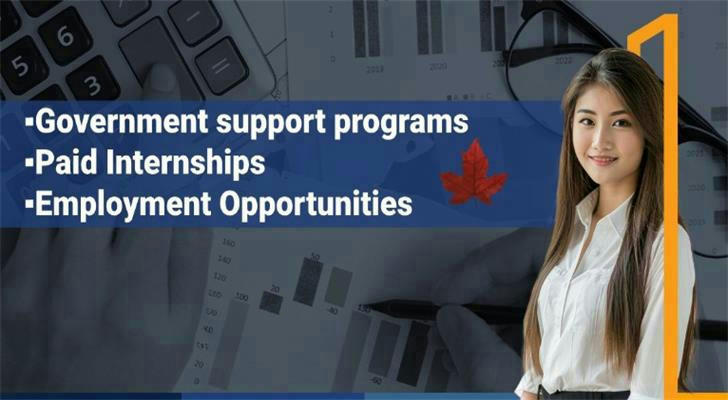Get A Payroll Clerk Certificate Easily With A Subsidy From The Canadian Government
This program helps low-income people, new immigrants and people without a degree to obtain a stable income
No prior experience or degree required. You can enroll in government support payroll clerk certification training at minimal cost and enter the thriving job market with a salary of $60,000 per year plus generous benefits

Government-Supported Payroll Clerk Certification
Educational disparities and economic hardship should not be a barrier for anyone to have a better life. These programs prioritize low-income people, people without higher education, and new immigrants.
1️⃣ Second Career Program (Ontario)
- Who it’s for: Unemployed or underemployed workers (e.g., retail, hospitality, gig workers).
- What it covers: Up to $28,000 for tuition, childcare, and living expenses while you train.
- No degree? No problem: Many payroll courses only require a high school diploma or equivalent.
2️⃣ Skills Centre Payroll Courses
- Example: Manitoba’s Employment and Income Assistance (EIA) Program funds 16-week payroll training for recipients. Graduates earn an average of $48,000 within 1 year.
- Hands-on focus: Learn practical skills like using payroll software (e.g., QuickBooks) instead of theory-heavy coursework.
3️⃣ Canadian Payroll Association (CPA) Scholarships
- For low-income applicants: The CPA offers reduced fees for its Payroll Compliance Practitioner (PCP) certification. Over 1,200 scholarships were awarded in 2023.
4️⃣ Alberta’s Skills for Employment Program
- Key perk: Covers transportation and work attire costs—critical for those living paycheck to paycheck.
5️⃣ Canadian Institute of Science and Technology (CST College):
- Provides government support vocational training for the unemployed, including payroll clerk certification courses, with financial aid options.
Why Get Payroll Clerk Certification Training
💰 Escape the “Survival Job” Cycle
2025 Projection: The average salary for a clerk in Canada is $60,000, and the highest hourly wage in Nunavut is $46 per hour.
Example: A Walmart cashier working 35 hours/week earns ~$30,000 annually. A payroll clerk with a 6-month certification can start at $45,000.
🎓❌ No Degree? No Problem
Over 60% of payroll clerk job postings in Canada do not require a university degree. Employers prioritize certification and experience.
👪 Stability for Families
Full-time payroll roles include benefits like dental coverage (87% of jobs) and paid sick days—a game-changer for parents relying on food banks or skipping doctor visits.
💻 Work Remotely or Part-Time
Many payroll jobs offer flexible hours or remote work, ideal for single parents or caregivers.
Advantages of Payroll Clerk Certification
✅ Affordable Training
Programs like Second Career reimburse more than 90% of tuition for low-income applicants. In Nova Scotia, the Career Seek Program even reimburses exam fees for CPA certifications.
✅ No Experience Needed
Courses start with basics: math refreshers, computer literacy, and Canadian workplace norms. Newcomers with language barriers get extra ESL support.
✅ Ample internship opportunities
Real-world example: The Toronto Immigrant Employment Council partners with payroll programs to place newcomers in paid internships. 80% of participants land full-time jobs.
✅ Wide range of employment fields
Payroll clerks are suitable for multiple industries, including corporate finance departments, human resources departments, accounting firms, and government agencies. Since all companies need to process employee wages, there are many employment opportunities for this position.

Graduates change their lives 🤝
Carlos: From Janitor to Payroll Supervisor
Carlos, a high school graduate, cleaned offices for 12 years, earning $32,000. After a back injury made physical work impossible, he used BC’s WorkBC funding to enroll in a 4-month payroll course. Today, he manages payroll for a chain of dental clinics, earning $63,000. “I finally have savings,” he says.
Fatima: Refugee Mom Builds a New Life
Fatima fled Syria with her three children and worked night shifts at a bakery. Through Ontario’s Jumpstart Program, she earned her CPA certification while receiving subsidized childcare. She now works remotely for a nonprofit, earning $52,000. “My kids see me in a suit now—they’re proud,” she shares.
Tom: High School Dropout to Payroll Manager
Tom dropped out at 17 and worked warehouse jobs for 20 years. At 40, he qualified for Alberta’s Rapid Training Fund and completed a 12-week payroll course. He now oversees payroll for a construction company, earning $68,000. “I thought I’d die in that warehouse,” he says. “This job saved me.”
Simple Steps to Start 📈
- Find Funding: Contact your provincial employment office (e.g., Ontario Works, Alberta Supports).
- Choose the Right Program: Opt for short courses (3–6 months) with internships.
- Leverage Support Services: Many programs include resume help, interview coaching, and mentorship.
Summarize 🚀
Payroll clerk certification isn’t just a career path—it’s a way out of poverty for those trapped in low-wage jobs. With government programs covering costs, flexible training for busy lives, and employers desperate to hire, this is your chance to rewrite your story. You don’t need a degree. You don’t need savings. You just need the courage to take the first step.
Your future starts today—not 4 years from now.
